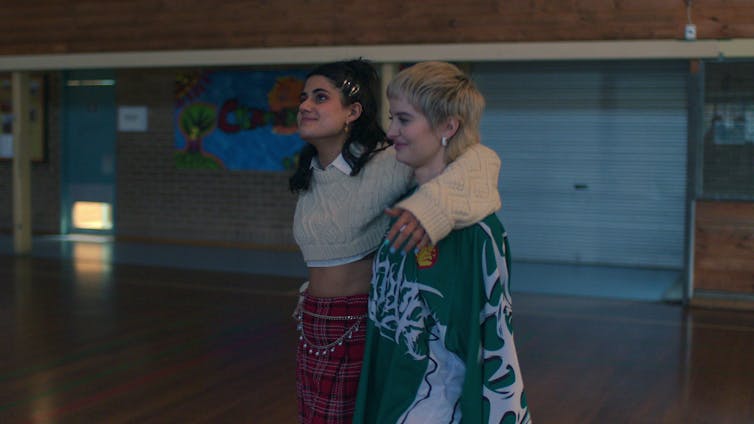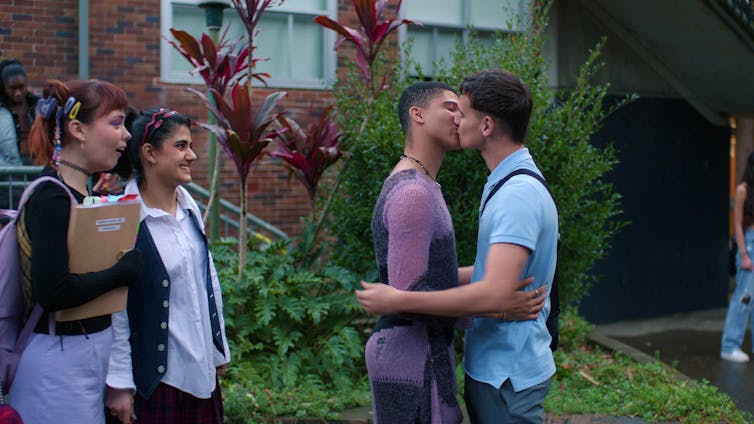The new season of Heartbreak High is garnering mixed reviews.
Critics are writing about the racy story lines, comparing it to other coming-of-age series about teenage relationships and sex such as Riverdale and Sex Education. Both seasons have been praised for their representation of cultural diversity – but I think the reviews are missing the real cultural influence of the show.
In this new season, the representation of culturally diverse characters on the grounds of Hartley High is “banal multiculturalism”. While season one looked closely at the entrenched racism of institutions, season two goes beyond events and institutions to explore a multifaceted, everyday reality.
In exploring this banal multiculturalism, the show gets closer to showing us everyday Australia.
Full young lives
What Heartbreak High excels at, especially in this second take, is in delving deeper into the complexity of the characters, many of whom hail from under-represented and misrepresented social groups.
In the first season, the police attack Indigenous character Malakai (Thomas Weatherall) without provocation when he is walking home after a Mardi Gras event. In another scene, Darren (James Majoos), who is mixed-race, is warned by his father about hiding goods stolen by his white boyfriend as the police were more likely to suspect him of the crime.
Season two does not have these explicit references to race-based political events or racist institutions. Here, backstories and character arcs help us see the everyday aspects of being a multicultural or First Nations young person.
Unlike in season one, this complexity does not render them simply as victims of a brutal system, but as having agency to heal themselves and represent others like them.

Amerie (Ayesha Madon) is sometimes unlikeable due to her prior popular girl narcissism in season one. In the new season, she grows into more courage and accountability as she runs for school captain and rescues a fellow student from a school fire, despite the fact he had been conspiring against her the whole term.
Sasha (Gemma Chua-Tran) lives her life with an unapologetic queerness and somewhat imperfect vegan politics. Her Asian-ness only comes to light in one scene where she talks about going to a Chinese restaurant to eat a meat dish. Her overall persona is more “social justice warrior” than representative of a single ethnic group.
Missy (Arrernte actor Sherry Lee-Watson) is a feisty teenager. In a memorable scene where the school captain candidates are headed to a formal event to raise funds for their campaigns, Missy coolly gets rid of her chewing gum by pasting it on the portrait of King Charles II adorning the venue’s corridor.
In not framing these characters as solely defined by their racialised identity – but still conscious of living in a racist society – Heartbreak High gives them new agency. First Nations lingua franca (such as “deadly” and “yarn”) are peppered throughout the season and not explained for global viewers.
This is what I mean by banal multiculturalism: the use of this language is integrated as normal and everyday. This is powerful for communities who have often been positioned as needing translation. Here, they are not so much integrated as centred and normalised.
Towards an aspirational multiculturalism
Race-based stereotyping is still a reality in Australian schools. This new season of Heartbreak High helps us aspire to a multicultural future in which young people can transcend ethnic boxes.
The season certainly has its flaws and unrealistic plots. However, it manifests what I have called “aspirational multiculturalism”.
These depictions are not post-racial, but aspirational: they help us imagine a reality that is more justice-oriented than the current one. While racism exists in society, these students carve out a space in which their difference endows them with confidence and helps them to eventually express solidarity with their peers.
The new season shows us what we could be – and helps shape a more just multicultural society.

Diverse young voices
The first season of the reboot appealed to both those who watched the series in the ’90s and fresh Gen Z viewers.
The second season may not be able to retain all its older viewers, but some might persist to get another glimpse into the lives of young people and the social issues of the near future.
The coming-of-age genre transcends generations. It is no surprise representing complex culturally diverse characters is trialled in such stories.
Other recent examples on Netflix of diverse young adult content include Never Have I Ever and The Babysitter’s Club (also a reboot). These shows have heralded a new generation of content creators and actors who are centring non-Anglo stories, and doing so in ways that champion culture as a part of the messy story of growing up.
Such young adult shows are inspiring for the next generation of non-white creatives, and signal a social change agenda for all generations.
A lasting legacy
Since 2016, we have seen a doubling of non-European representation on Australian television. But people with Indian, Chinese, Filipino and Vietnamese ancestry are still under-represented, even as their populations in Australia are growing.
It is here I think the reboot could have a legacy beyond helping with the careers of a very talented young cast. Heartbreak High comes at a time of seemingly deep cultural divides, but also of generations of digitally exposed youth who are being more thoughtful about what media they engage with and are shaped by.
What is likely to make a lasting impact is the normalisation of diversity for this generation, setting the benchmark for other local productions.
Banal multiculturalism in screen drama is the future of television. Not just because it is proving to be successful with viewers, but also because it is the future we should shape for generations to come.

